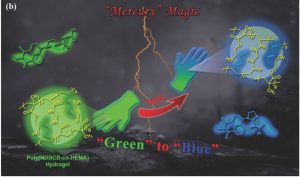In the renowned “Snow White” fairy tale, the witch queen tempts the princess with a poisoned apple, which nearly resulted in her being perished. Nowadays, there have been many similar “posioned apples” in our real world, e.g. mercury ions (Hg2+) polluted food and water, because of human industrial activities. To protect humanity from mercury-poisoning, many Hg2+-detection methods have been developed. Despite state-of-the-art, however, these methods usually suffer from restricted sensitivity and time-consuming operations.
In their recent paper in Advanced Materials Technologies, Dr. Wei Lu, Prof. Tao Chen from the Ningbo Institute of Materials Technology and Engineering, Chinese Academy of Sciences, China, and Prof. Jintao Yang from the Zhejiang University of Technology, China, report a rapid Hg2+-sensing material that enables fast detection of ppm-level Hg2+ in complex real-world food and water samples within minutes.

Fluorescent hydrogel‐coated wearable sensing gloves that display visible “green‐to‐blue” emission color upon touching the mercury-polluted food samples (click to enlarge).
The developed rapid Hg2+-sensing material is based on specially-designed hydrophilic fluorescent hydrogel-coated flexible paper/textile film. It reports Hg2+-polluted food and water through a noticeable “green-to-blue” fluorescence color change. Due their hierarchical porous structures fixed by interwoven paper/textile fibers, this new method allows capillary-force-driven fast diffusion of mercury pollutants into the sensing materials, thus enabling fast detection as well as a high sensitivity. Moreover, to facilitate infield detection and ensure safe operation, robust wearable mercury sensing gloves are also fabricated.
This is the first flexible and wearable mercury detection appliance, which is believed to represent a notable advance towards in-field food and water analysis. According to the researchers, one can imagine that the mercury-polluted meats, seafood, juice and drinks will be easily discriminated if food processing packers get the opportunities to wear the developed new-concept sensing gloves. This may also inspire the future construction of more powerful wearable detection apparatus for other important food and water pollutants. After all, we do want to keep the Snow White fairytale alive.

















